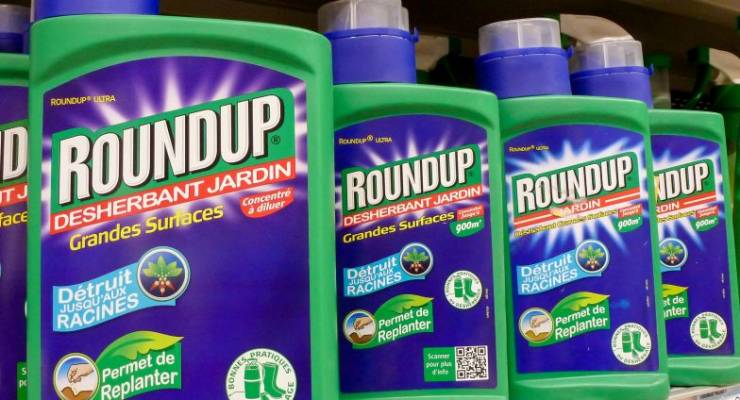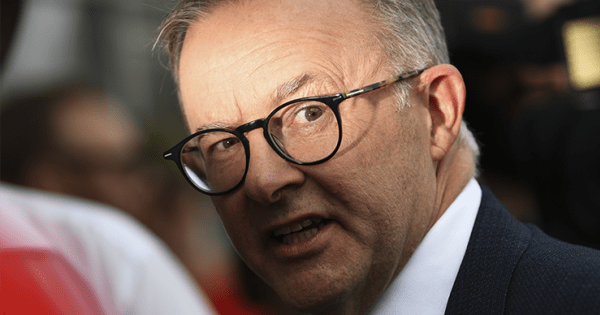
The first Australian lawsuit against popular weed killer, Roundup, has been filed in the Supreme Court of Victoria and with it, a decades-long game of spin and misdirection arrives on our shores.
Nine reported on Tuesday that 54-year-old Melbourne gardener, Michael Ogalirolo, alleges that more than 18 years of exposure to glyphosate — the active component in Roundup, and the most common weed killer in the world — is to blame for his non-Hodgkin lymphoma.
Monsanto, the agrichemical giant behind Roundup and several other “life sciences” products, was purchased last year by German pharmaceutical corporation, Bayer.
The company’s website screams corporate transparency. Blog posts answer scripted user-questions like “What does Monsanto do? All I know is what other people are saying: via documentaries on Netflix and what the political pundits say?” while another post promises to give the facts about glyphosate reassure readers that it has a “40-year history of safe and effective use”.
After many years, it appears Monsanto has perfected its public-facing messages over safety concerns. Crikey takes a deeper look at those concerns and the scandals plaguing the chemical manufacturer.
Decades dodging safety concerns
Roundup trials are hardly Monsanto’s first rodeo.
While best known for its weed-killer, Roundup, Monsanto was originally a chemical company producing machine coolants along with several other food and pharmaceutical industry products.
During the last century, the US Department of Agriculture attempted to ban Monsanto’s artificial sweetener saccharin due to safety concerns. Monsanto also manufactured dioxin and Agent Orange, which later were used in military warfare and banned in several countries. The company also made polychlorinated biphenyls (PCBs) used for machine coolants which were banned in the US in 1979 after governments realised how toxic and persistent it was in the environment.
It was only after a series of crippling court cases and the prohibition of several of its products that, by the mid-1990s, Monsanto rebranded its scandal-ridden chemical corporation into a life-sciences company with the creation of Roundup.
Since then, Monsanto, and now Bayer, have attempted to neutralise growing public outcry against its products, biotechnology, and genetically modified foods.
Monsanto has been emphasising its accountability, sustainability, and dedication to helping farmers grow their best produce. Its website doesn’t acknowledge its scandal-clad history. The company’s UK site states that “While we share the name and history of a company that was funding [chemical production] in 1901, the Monsanto of today is focused on agriculture and supporting farmers around the world in their mission to produce more while conserving more. We’re an agricultural company”.
Glyphosate’s cancer-link confirmed
In 2015, the World Health Organisation body, the International Agency for Research on Cancer (IARC), classified glyphosate as “probably carcinogenic to humans”. While Monsanto, and most regulators, have stood by the relative safety of Roundup, several court challenges have called their conviction into question.
In August 2018, a California jury found Monsanto had failed to warn school groundskeeper Dewyane Johnson — who applied the Roundup weed killer up to 30 times per year — and other consumers of the cancer risks posed by its products. It was the first case to go to trial against the corporate agriculture giant alleging glyphosate causes cancer. Johnson, who alleged Monsanto’s Roundup products were a substantial factor in causing his terminal non-Hodgkin lymphoma, was awarded $289 million in damages. Johnson’s doctor’s said it’s unlikely for him to live beyond 2020.
The company promised to appeal the decision: “Today’s decision does not change the fact that more than 800 scientific studies and reviews … support the fact that glyphosate does not cause cancer, and did not cause Mr Johnson’s cancer,” the company said in a statement.
But the trial was a turning point for alleged glyphosate victims: it exposed the potential link between one of the world’s most widely used herbicides and non-Hodgkin lymphoma, an aggressive form of cancer that attacks the body’s immune system.
Now, the company reportedly faces more than 5,000 similar cases from cancer patients, survivors, and families of lost loved ones to non-Hodgkin lymphoma across the US.
Courts have since continued to find in favour of the plaintiffs. Edwin Hardeman, who sprayed his properties with Roundup, was awarded $80 million earlier this year in the first federal trial against Monsanto. As recently as May, a California jury ordered the agrochemical corporation to pay more than $2 billion to a couple that got non-Hodgkin lymphoma after using the weed killer — the third and largest verdict against the company over Roundup.
The trials have also revealed Monsanto’s efforts to influence news media and scientific research. According to the New York Times, Monsanto ghostwrote a column for Henry I. Miller which was published in Forbes in 2015. In 2017, former researcher and Monsanto employee, John Acquavella, expressed in emails to a company executive his concern of the way Monsanto was trying to present academic authorship, saying “we call that ghost-writing and it is unethical”.
What the challenge means for Australia
Despite Monsanto’s recent reassurance that glyphosate is not carcinogenetic, governments and health bodies are taking action. The Victorian government has announced a review into the safety of the weed killer. The Cancer Council Australia has also called for an independent review of the product and several councils across Melbourne and Sydney are considering a ban on Roundup and other products containing glyphosate, Nine reported.
In addition to Ogalirolo’s Supreme Court challenge, The Guardian Australia reported over the weekend that at least two Australian law firms are considering filing law suits against the manufacturer, having fielded hundreds of inquiries since late 2018 from people exposed to glyphosate.
While Roundup’s commercial future in Australia is in doubt, one thing is for sure: potential litigation against the company is multiplying, and for once, Monsanto cannot rely on its darling product to take care of its pests.








Amazing that an article with so much anecdote and hearsay didn’t have one ounce of actual science in it…
Well the first thing about this article is that it is full of holes and I hope Crikey hasn’t paid the writer for producing it.
Be careful what you wish for.
Chris Jones rightly raises a lot of issues regarding what would happen without glyphosate in our farming system.
There are tonnes of studies that show when used as directed it doesn’t cause cancer. The IARC report has some significant holes in it.
Have a look at one of the biggest epidemiological studies in the world The Agricultural Health Study – https://aghealth.nih.gov/
Or an Australian approach – https://theconversation.com/stop-worrying-and-trust-the-evidence-its-very-unlikely-roundup-causes-cancer-104554
It is difficult to keep the emotion out of this arguments, but it helps to have an open an enquiring mind.
I expect better of you, Crikey. This is one-sided and ill-informed sensationalism.
The effectiveness of glyphosate as a weed killer is unprecedented. It has reduced the total volume of pesticides and herbicides needed to grow Roundup-resistant crops; enabled the introduction of minimum tillage production systems which have protected soil structure; improved soil moisture retention; and increased soil carbon storage.
Much of the opposition to it has been based on a report by the International Agency for Research on Cancer (IARC) in 2015 which claimed to find evidence that glyphosate is “probably carcinogenic” (as is burnt toast). That report has now been discredited.
No other herbicide has been subjected to as many rigorous tests and investigations as glyphosate and there is no scientific proof that it has harmed anyone.
Some chemicals are highly toxic in very small doses. Glyphosate is not one of those. Its LD50 – the lethal dose for 50% of rats in testing – is 5,600 mg/kg. The LD50 for caffeine is 192 mg/kg.
The US Agricultural Health Study has been tracking 89,000 farmers who use glyphosate for 23 years. It has found “no association between glyphosate exposure and all cancer incidence or most of the specific cancer subtypes evaluated.”
At the same time, there is clear evidence that it has kept millions of people alive because we’ve been able to sustainably produce more food and fibre from finite resources of land and water.
A recent study concluded banning glyphosate would have significant effects on world well-being. There would be an annual loss of global farm income gains of US$6.76 billion; a net increase of 8.2 million kg pa of herbicide usage; additional carbon emissions arising from increased fuel usage and decreased soil carbon sequestration, equal to adding 11.77 million cars to the roads. As well, land use changes to meet demand for increased croplands would create an additional 234 million tonnes of CO2 emissions. And it was estimated that global welfare would fall by US$7,408 million per year.
In 2017, the European Food Safety Authority completed a reassessment of glyphosate as part of the EU’s pesticide renewal process, which included a consideration of the IARC assessment. Using a risk-based, weight-of-evidence assessment approach, EFSA considered an extensive body of scientific evidence and determined that there was no credible evidence that glyphosate causes cancer in humans.
Australia’s risk-based, scientific approach to regulation ensures that each agricultural chemical product is thoroughly and independently assessed by the Australian Pesticides and Veterinary Medicines Authority (APVMA) prior to registration and supply. It is required under legislation to ensure that any pesticides registered for use in Australia have been through a robust chemical risk assessment process and are safe to use, provided they are used as per the label instructions. This registration system is supported by a range of post-market surveillance, compliance, audit verification and review activities that ensure products available in Australia continue to be used safely and effectively.
In 2016, the APVMA conducted an evaluation that included a commissioned review of the IARC monograph by the federal Department of Health, and risk assessments undertaken by expert international bodies and regulatory agencies.
The review was commissioned by the Department of Health, and was conducted in two phases. The first phase identified which studies relied on by IARC should be reviewed in more detail, while the second phase involved a detailed assessment of those studies.
Following this detailed and comprehensive review, the APVMA concluded that glyphosate does not pose a carcinogenic risk to humans and that there are no grounds to place it under formal reconsideration.
Yet the alarmists persist.
Sadly, we live in an age where rational science-based evidence struggles to stand against ill-informed opinion; and the divide between those growing food and those eating it is stark.
In this environment, it is all too easy to succumb to stereotypes. Farmers are often vilified as profit-hungry and careless, belittled as simple, and written-off as stubborn. And many farmers assume those who live in the city are naïve and hypocritical.
There is no easy solution to this problem. However, instead of throwing fuel on the fires, we need to work on bridging those gaps.
We can start with taking a calm look at the science behind glyphosate and considering the whole picture, rather than responding with simplistic ill-informed knee-jerk reactions like this one.
Jan, long on repeating ad nauseum the claims of the manufacturer, short on addressing the fact that courts are finding in the plaintiff’s favour. So it doesn’t really matter what the “science” is – if a government worker sues a government in an Australian court and wins, what is that government supposed to do? I understand that there is nothing around like glyphosate, nothing. If wheat and other farmers continue to use the stuff and begin to die in numbers and successfully sue the manufacturers, what will other farmers do? Do you really think they will persist against the odds on the basis that the science is not settled?
Hugh, I would agree with you if farmers were in fact dying in droves, instead, after decades of use that isn’t happening (from the little reading I’ve done so far). The difference with smoking was that no matter how much the tobacco companies commissioned research to say smoking was safe, smokers were dying in their thousands all over the world which was kind of difficult to ignore.
The US Agricultural Health Study has been tracking 89,000 farmers who use glyphosate for 23 years. It has found “no association between glyphosate exposure and all cancer incidence or most of the specific cancer subtypes evaluated.”
The science is settled. Whether or not courts accept the science is a totally different matter.
I love to hate chemical companies as much as anyone and I am not necessarily defending either the chemical company products or the legal conclusions drawn in American courts. Cancer invokes emotive and empathetic reactions, but uncritically embracing the outcomes of American court cases as proof of the hypothesis that glyphosate “causes” cancer should be done cautiously.
These were litigation cases to seek answers that would hopefully enable compensation for a death from cancer, not scientific epidemiological studies of causes of cancer.
It is difficult to “prove” what combination of specific genetic and cumulative and diverse environmental factors can “cause” cancer in anyone.
I do not know the scientific literacy level of the article’s author, but that the WHO classified glyphosate as “probably carcinogenic to humans” does not mean that “Glyphosate’s cancer-link confirmed” which is the misleading heading in the article and which I assume is the conclusion of the author. If subject matter is not within anyone’s expertise they or editors should recognise that appropriate expert advice or scrutiny of a written article is needed before publication, lest reinterpreted information wander into the realm of
”fake news”.
People need to know all “chemicals” need to be used with utmost care, even those touted as “natural” and it is prudent to be skeptical of any good or bad safety claims, and equally personal claims of damage. Humans are slow learners, and duty of care in use is often not taken seriously by people and flagrant and ignorant misuse is always on the cards . The precautionary principle and unbiased science should guide us.
https://sciencebasedmedicine.org/update-on-glyphosate/
https://www.acsh.org/news/2018/10/09/if-you-accept-science-you-accept-roundup-does-not-cause-cancer-13490